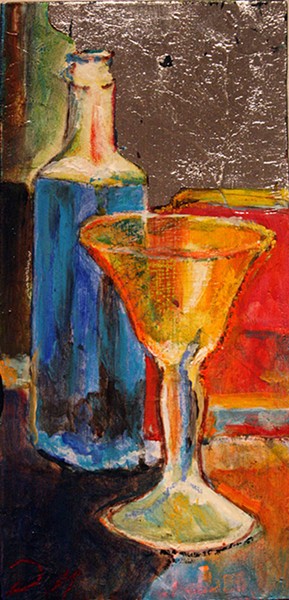Demetri Mitsanas' new collection of paintings started as utter garbage. After his daughter gave him some strange bottles found in a Berkeley dumpster, he composed them, painted them with vibrant Mediterranean shades and fell in love with all of the possible compositions. Gold leaf and saturated hues may hide the humble beginnings of these paintings, but the bottles proclaim Mitsanas' new muse.
Demetri Mitsanas is usually known for his sumptuous, erotic paintings: nude women lounging with luscious fruit or posing among flannel shirts. Copper buckets, porcelain bowls and, yes, bottles, have also featured prominently in his work, but this is the first time they're front and center. His new show, Color, Glass and Light, opening this weekend at Humboldt State University's First Street Gallery, contains 33 paintings composed almost entirely of vessels. Martini glasses, tilted oblong orbs, beakers, vases, shallow cups, square bottles and goblets are all drenched in overwhelming color. It's not a big leap to move from bodies to bottles, and the sheer number of objects Mitsanas has painted veers precariously close to obsession.
After arranging his first assortment of vases and bottles, Mitsanas became absorbed with the glassy surfaces and fascinating reflections. His early paintings went quickly, taking about 20 hours each, and he liked the swift progress of still lifes rather than painting from a model. He frequented thrift stores, looking for new and interesting shapes to satisfy his compositional curiosity, and quickly amassed over 400 pieces.
This show isn't just about form though. Mitsanas is, above all else, a colorist. On a fading autumn afternoon at his Humboldt Hill home, sunlight illuminates small scallops on the rim of his porcelain coffee cup, his waves of white hair and his full, white moustache. With a piercing stare and professorial tone Mitsanas notes, "Those glasses become the vehicle for the application of color." Like the soft peachy glow of a model's skin, the myriad shapes of his vessels are given life through innumerable hues, with each painting exploring a slightly different palate.
Still Life #27, for example, features one of the more simple assemblies, with a glowing orange goblet sitting prominently in the foreground. Mitsanas' loose brush strokes define the contours of the glass, fluently capturing its glossy surface. Behind it, a cobalt bottle reflects other colored shapes, its neck blushing crimson on one side and green on the other. A flourish of blue reveals the translucent stem of the goblet, emphasizing the dialogue between color and form that has so captured Mitsanas' attention. As with all of his pieces, accents of buttery oil pastels rest gently above the acrylic paint and silver leaf floods the background.
The juicy colors may dress up the somewhat banal subjects, but underlying these unpretentious vessels is a piece of the artist's past. Born in Tripoli, Greece, Mitsanas' childhood was deeply affected by the German occupation of World War II, followed by the Greek civil war. He recalls his friends being blown up playing with abandoned land mines and bodies hanged from balconies by the Nazis. Money and resources were tight, and Greek families cherished the few things they had, including bottles for their olive oil, vinegar and wine. If a young boy got distracted by a soccer match on the way to the market and set his bottles down they would likely disappear.
Growing up, Mitsanas was discouraged from pursuing his artistic impulses. His brother was a good student, but Demetri Mitsanas disdained the "brutal memorization" required in school. He gathered art materials haphazardly, informally teaching himself the fundamentals of drawing and painting. Now, many years later, the professor emeritus of art and art history at HSU, who celebrated his 80th birthday in August, claims that art helps him hold on to his youth. "That's the amazing thing about the arts," he says in his unhurried Greek accent, "You keep young, when you're really getting old."
Mitsanas compares making art to a playground. "There's no directions, no supervision. It's you and your abilities." This freedom to do whatever comes to mind can lead to exciting discoveries as he watches his styles, tastes and working methods evolve over time. Squinting his right eye to emphasize his point, he asks, "Can you imagine the excitement of creating something and you're the first to see it?" Mitsanas laughs, adding, "You become like a kid in a candy shop!"
The countless colors in his new body of work may resemble a candy shop, but it might be better to describe them in more adult terms. Standing in front of the massive "Still Life Triptych," the more than 90 vessels of every shape and size are somewhat overwhelming, like looking at the back of a bar. The squiggly images of each vessel's neighbor bounce back and forth, emphasizing the reflectivity of the glass. Much like the mirrors behind a bar, Mitsanas' extensive patterning of gold leaf allows the viewer to become part of the paintings themselves. Moving in front of the works, it's hard not to notice your reflection subtly staring back at you.
Given that this type of creative play could go on forever, how does Mitsanas know when a work is complete? Couldn't he just keep fooling around with color and form, piling on more and more paint and pastel? He pauses to think, offering an answer that harkens back to his more erotic works. "A comparison: How do you know that a love affair is complete?"
These paintings are surely a love affair for Mitsanas, who has spent the past three years building this new body of work. "Hundreds of hours I've looked at those paintings, and I'm fascinated when other people look at them." If you, too, would like to get a gander at this one-time trash transformed into fine art, First Street Gallery is having an Arts! Alive reception on Dec. 7 from 6 to 9 p.m.



Comments